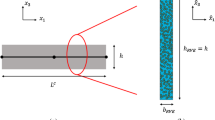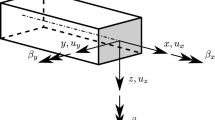Abstract
This contribution proposes a multiscale scheme for structural elements considering beam kinematics. The scheme is based on a first-order homogenization approach fulfilling the Hill–Mandel condition. Within this paper, special focus is given to the transverse shear stiffness. Using basic boundary conditions, the transverse shear stiffness drastically depends on the size of the representative volume element (RVE). The reason for this size dependency is identified. As a consequence, additional internal constraints are proposed. With these new constraints, the homogenization scheme leads to cross-sectional values independent of the size of the RVE. As they are based on the beam assumptions, a homogeneous material distribution in the length direction yields optimal results. Furthermore, outcomes of the scheme are verified with simple linear elastic benchmark tests as well as nonlinear computations involving plasticity and cross-sectional deformations.




































Similar content being viewed by others
References
Buannic N, Cartraud P (2001) Higher-order effective modeling of periodic heterogeneous beams. II. Derivation of the proper boundary conditions for the interior asymptotic solution. Int J Solids Struct 38(40–41):7163–7180
Carrera E, Giunta G, Nali P, Petrolo M (2010) Refined beam elements with arbitrary cross-section geometries. Comput Struct 88(5–6):283–293
Cartraud P, Messager T (2006) Computational homogenization of periodic beam-like structures. Int J Solids Struct 43(3):686–696
Coenen EWC, Kouznetsova VG, Geers MGD (2010) Computational homogenization for heterogeneous thin sheets. Int J Numer Methods Eng 83(8–9):1180–1205
Feyel F (1998) Application du calcul parallèle aux modéles á grand nombre de variables internes, PhD Thesis. ONERA
Feyel F, Chaboche JL (2000) FE2 multiscale approach for modelling the elastoviscoplastic behaviour of long fibre SiC/Ti composite materials. Comput Methods Appl Mech Eng 183(3–4):309–330
Geers MGD, Coenen EWC, Kouznetsova VG (2007) Multi-scale computational homogenization of structured thin sheets. Model Simul Mater Sci Eng 15(4):S393–S404
Gruttmann F, Wagner W (2001) Shear correction factors in Timoshenko’s beam theory for arbitrary shaped cross-sections. Comput Mech 27(3):199–207
Gruttmann F, Wagner W (2013) A coupled two-scale shell model with applications to layered structures. Int J Numer Methods Eng 94(13):1233–1254
Gruttmann F, Wagner W (2017) Shear correction factors for layered plates and shells. Comput Mech 59(1):129–146
Gruttmann F, Sauer R, Wagner W (1998) A geometrical nonlinear eccentric 3D-beam element with arbitrary cross-sections. Comput Methods Appl Mech Eng 160(3–4):383–400
Gruttmann F, Wagner W, Sauer R (1998) Zur Berechnung von Wölbfunktion und Torsionskennwerten beliebiger Stabquerschnitte mit der Methode der finiten Elemente. Bauingenieur 73:138–143
Gruttmann F, Knust G, Wagner W (2017) Theory and numerics of layered shells with variationally embedded interlaminar stresses. Comput Methods Appl Mech Eng 326:713–738
Heller D, Gruttmann F (2016) Nonlinear two-scale shell modeling of sandwiches with a comb-like core. Compos Struct 144:147–155
Hill R (1952) The elastic behaviour of a crystalline aggregate. Proc Phys Soc London Sect A 65(5):349–354
Hodges DH (2006) Nonlinear composite beam theory, vol 213. Progress in astronautics and aeronautics. American Institute of Aeronautics and Astronautics, Reston
Klinkel S, Govindjee S (2002) Using finite strain 3D-material models in beam and shell elements. Eng Comput 19(3):254–271
Kollbrunner CF, Meister M (1961) Knicken, Biegedrillknicken, Kippen. Springer, Berlin
Markovič D, Ibrahimbegović A (2004) On micro-macro interface conditions for micro scale based fem for inelastic behavior of heterogeneous materials. Comput Methods Appl Mech Eng 193(48–51):5503–5523
Saeb S, Steinmann P, Javili A (2016) Aspects of computational homogenization at finite deformations: a unifying review from Reuss’ to Voigt’s bound. Appl Mech Rev 68(5):050801
Sayyad AS (2011) Comparison of various refined beam theories for the bending and free vibration analysis of thick beams. Appl Comput Mech 5:217–230
Schröder J (2000) Homogenisierungsmethoden der nichtlinearen Kontinuumsmechanik unter Beachtung von Stabilitätsproblemen. Habilitation, Bericht Nr I-7 aus dem Institut für Mechanik (Bauwesen), Universität Stuttgart
Simo JC, Vu-Quoc L (1991) A geometrically-exact rod model incorporating shear and torsion-warping deformation. Int J Solids Struct 27(3):371–393
Timoshenko SP, Goodier JN (1951) Theory of elasticity. McGraw-Hill, New York
Vlachoutsis S (1992) Shear correction factors for plates and shells. Int J Numer Methods Eng 33(7):1537–1552
Wackerfuß J, Gruttmann F (2009) A mixed hybrid finite beam element with an interface to arbitrary three-dimensional material models. Comput Methods Appl Mech Eng 198(27):2053–2066
Wackerfuß J, Gruttmann F (2011) A nonlinear Hu-Washizu variational formulation and related finite-element implementation for spatial beams with arbitrary moderate thick cross-sections. Comput Methods Appl Mech Eng 200(17–20):1671–1690
Wagner W, Gruttmann F (2001) Finite element analysis of Saint–Venant torsion problem with exact integration of the elastic–plastic constitutive equations. Comput Methods Appl Mech Eng 190(29–30):3831–3848
Wagner W, Gruttmann F (2013) A consistently linearized multiscale model for shell structures. In: Pietraszkiewicz W (ed) Shell structures. CRC Press, Boca Raton
Xu L, Cheng G, Yi S (2016) A new method of shear stiffness prediction of periodic Timoshenko beams. Mech Adv Mater Struct 23(6):670–680
Yu W, Hodges DH (2005) Generalized Timoshenko theory of the variational asymptotic beam sectional analysis. J Am Helicopter Soc 50(1):46–55
Author information
Authors and Affiliations
Corresponding author
Additional information
Publisher's Note
Springer Nature remains neutral with regard to jurisdictional claims in published maps and institutional affiliations.
Rights and permissions
About this article
Cite this article
Klarmann, S., Gruttmann, F. & Klinkel, S. Homogenization assumptions for coupled multiscale analysis of structural elements: beam kinematics. Comput Mech 65, 635–661 (2020). https://doi.org/10.1007/s00466-019-01787-z
Received:
Accepted:
Published:
Issue Date:
DOI: https://doi.org/10.1007/s00466-019-01787-z




